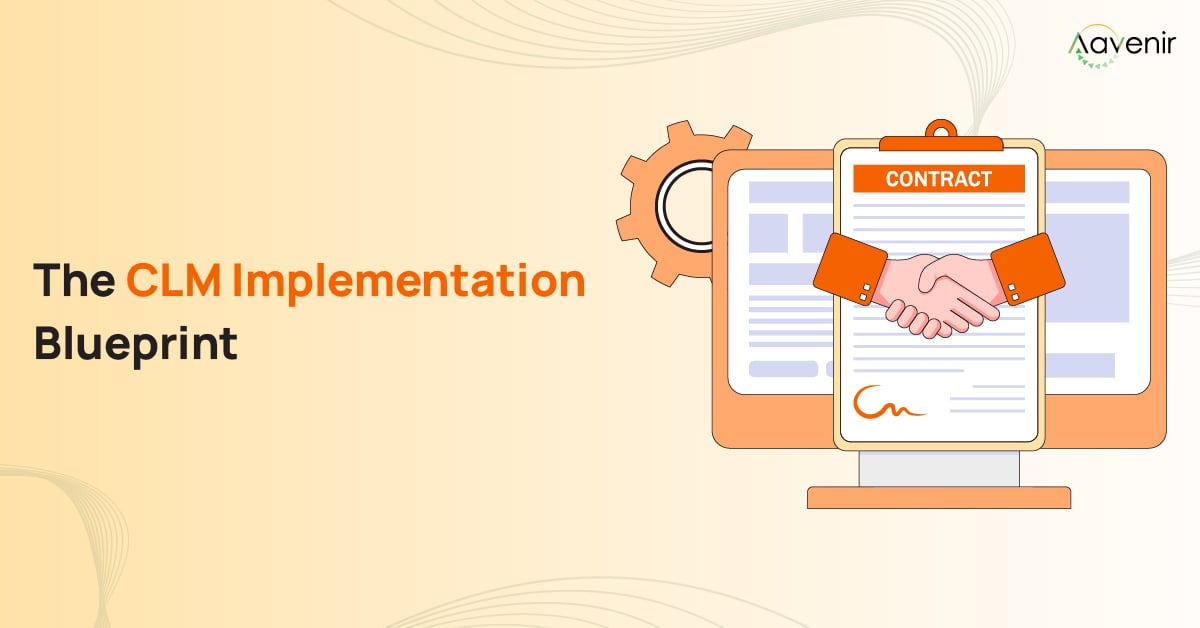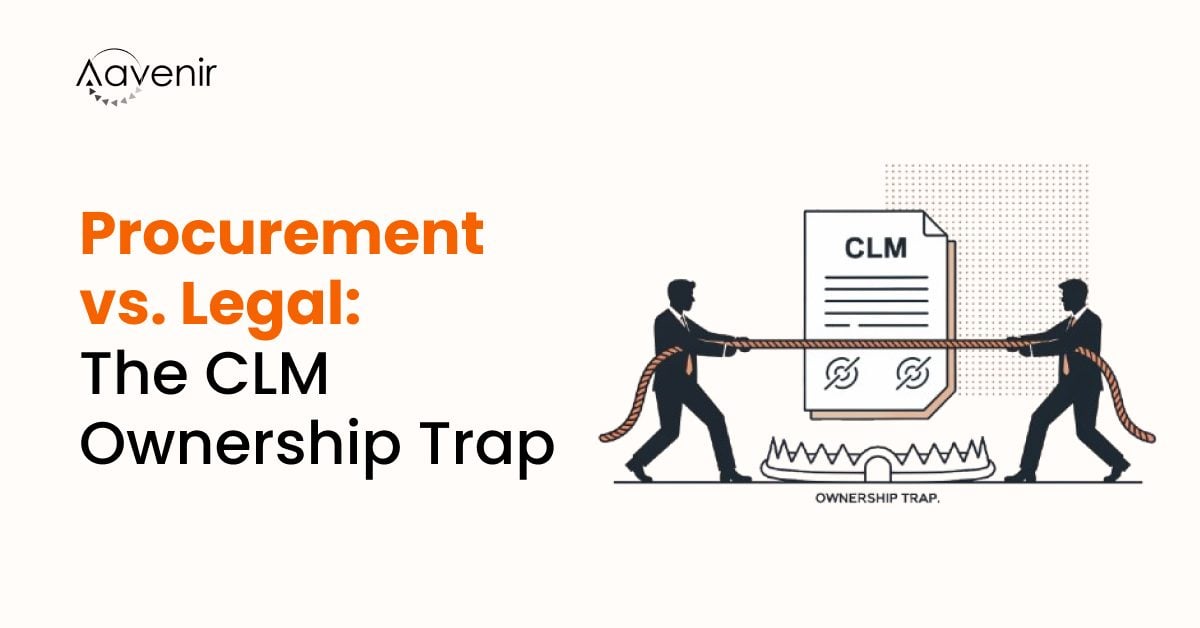Contract lifecycle management (CLM) has evolved from a nice-to-have tool to a business-critical necessity. As organizations grapple with increasing contract volumes, complex regulatory requirements, and the need for operational efficiency, implementing a robust CLM solution becomes paramount to success.
Yet, despite its importance, many CLM implementation projects fail to deliver expected results. Studies show that nearly 60% of enterprise software implementations face significant challenges, often stemming from poor planning, inadequate stakeholder buy-in, or misaligned objectives.
The difference between successful and failed CLM implementations lies in following a structured, comprehensive approach that addresses both technical and organizational challenges. This guide outlines ten essential steps that will help your organization navigate the complexities of CLM implementation and achieve measurable business outcomes.
Step 1: Define Contract Management Objectives
Before diving into vendor selection or technical specifications, successful CLM implementation begins with a crystal-clear objective setting. This foundational step determines whether your project will deliver transformative results or merely digitize existing inefficiencies.
Start by identifying specific, measurable business goals that align with your organization’s strategic priorities. Common CLM objectives include reducing contract cycle times by 40-60%, improving compliance rates to 95% or higher, enhancing contract visibility across departments, and minimizing revenue leakage through better renewal management.
Consider both immediate pain points and long-term strategic goals. While addressing urgent issues like contract bottlenecks or compliance risks provides quick wins, your CLM Implementation should also support future growth, regulatory changes, and evolving business models.
Engage stakeholders across legal, procurement, sales, and finance departments to understand their unique challenges and success metrics. A procurement team might prioritize supplier performance tracking, while legal teams focus on compliance monitoring and risk mitigation. Sales organizations often seek faster deal cycles and improved renewal visibility.
Document these objectives clearly and establish baseline metrics to measure improvement. This documentation becomes your North Star throughout the implementation process, helping prioritize features, guide vendor selection, and measure success.
Step 2: Assess Your Current Process and Workflows
Understanding your existing contract management landscape is crucial for designing an effective CLM solution. This assessment reveals inefficiencies, identifies automation opportunities, and helps set realistic improvement targets.
Begin by mapping your complete contract lifecycle, from initial request through renewal or termination. Document each stage, including stakeholder responsibilities, approval hierarchies, review cycles, and handoff points. Pay particular attention to bottlenecks where contracts frequently stall or require excessive manual intervention.
Analyze your current contract repository to understand document types, storage locations, and accessibility challenges. Many organizations discover contracts scattered across email systems, shared drives, individual computers, and physical filing cabinets, creating visibility gaps and compliance risks.
Evaluate stakeholder workflows and pain points through interviews and surveys. Legal teams might struggle with version control and redlining processes, while procurement professionals face challenges tracking supplier performance and contract renewals.
Quantify current performance metrics such as average contract cycle times, approval delays, compliance incidents, and resource allocation. These baseline measurements become the foundation for measuring CLM implementation success and calculating return on investment.
Step 3: Establish an Implementation Team
Successful CLM implementation requires cross-functional collaboration and clear governance structures. Assembling the right team with defined roles and responsibilities ensures smooth project execution and stakeholder buy-in.
Your implementation team should include representatives from key departments: legal, procurement, sales, finance, and IT. Each member brings unique perspectives and requirements that shape the final solution. Legal professionals understand compliance needs and risk management, while IT teams focus on integration requirements and security protocols.
Designate a project champion or executive sponsor who can remove obstacles, secure resources, and drive organizational change. This leader should have sufficient authority to make decisions and resolve conflicts between departments.
Establish clear roles and responsibilities for team members. Project managers coordinate activities and track progress, while subject matter experts define requirements and validate solutions. Change management specialists help drive user adoption and address resistance to new processes.
Create communication protocols and meeting cadences to maintain momentum and address issues promptly. Regular status updates, milestone reviews, and stakeholder feedback sessions keep the project on track and ensure alignment with business objectives.
Consider engaging external consultants or implementation partners when internal expertise is limited. Many organizations benefit from experienced guidance on best practices, common pitfalls, and change management strategies.
Step 4: Select Your CLM Software
Choosing the right CLM solution is perhaps the most critical decision in your implementation journey. The market offers numerous options, from basic contract repositories to comprehensive platforms with advanced AI capabilities and extensive integration options.
Start by defining your evaluation criteria based on business requirements identified in earlier steps. Key considerations include scalability to support growth, integration capabilities with existing systems, security features to protect sensitive contract data, and user experience to drive adoption.
Evaluate AI and automation capabilities that can transform your contract management processes. Modern CLM solutions offer intelligent contract analysis, automated clause extraction, risk assessment, and predictive analytics that provide unprecedented insights into contract performance.
Consider deployment options including cloud-based, on-premises, or hybrid solutions. Cloud platforms typically offer faster implementation, automatic updates, and lower upfront costs, while on-premises solutions provide greater control over data and customization options.
Define your AI requirements early in the selection process. Modern CLM solutions should offer intelligent contract analysis, automated risk assessment, clause extraction capabilities, and predictive analytics. Determine whether you need natural language processing for contract review, machine learning for compliance monitoring, or AI-powered contract drafting assistance. These requirements will significantly influence your vendor selection and implementation strategy.
Switch to Aavenir Contractflow for 5X Better Visibility
Experience smarter, faster, compliant contracting with Aavenir Contractflow. Implement in hours and get started with contract intelligence.
Aavenir Contractflow stands out in the CLM market with its rapid deployment capabilities, intelligent automation features, and comprehensive integration ecosystem. The platform’s AI-powered contract analysis accelerates review processes while providing deep insights into contract performance and risk factors.
Step 5: Define Standardized Contract Templates & Clause Libraries
Before diving into technical implementation, establish standardized contract templates and comprehensive clause libraries that will form the foundation of your CLM system. This critical step ensures consistency, reduces legal risk, and accelerates contract creation processes.
Work with legal teams to identify your most common contract types including master service agreements, non-disclosure agreements, employment contracts, and supplier agreements. Analyze existing contracts to identify frequently used clauses, terms, and conditions that can be standardized across your organization.
Create template hierarchies that accommodate different business scenarios while maintaining legal consistency. Develop base templates for major contract categories, then create variations for specific situations, geographies, or business units. This approach balances standardization with flexibility needed for complex business requirements.
Build comprehensive clause libraries organized by category, risk level, and business function. Include alternative language options for different risk profiles and business scenarios. For example, your liability clauses might range from standard limitations to enhanced protections for high-risk engagements.
Implement approval workflows for template modifications to maintain governance while allowing necessary customization. Establish clear ownership between legal, business, and compliance teams for different template categories and clause types.
Step 6: Plan Your Implementation Strategy
A well-structured implementation strategy transforms your CLM vision into actionable steps with realistic timelines and resource allocation. This phase bridges the gap between vendor selection and actual deployment.
Develop a phased rollout approach that minimizes disruption while delivering early wins. Many successful implementations begin with pilot programs in specific departments or contract types before expanding organization-wide. This approach allows for learning, refinement, and stakeholder confidence building.
Create detailed project timelines with clear milestones and dependencies. Factor in time for data migration, system configuration, integration development, user training, and testing phases. Build buffer time for unexpected challenges and stakeholder feedback incorporation.
Define success criteria for each implementation phase. Early phases might focus on basic functionality and user adoption, while later phases emphasize advanced features and process optimization. Clear success metrics help maintain momentum and demonstrate value to stakeholders.
Establish governance structures for ongoing decision-making and issue resolution. Regular steering committee meetings, technical review sessions, and user feedback forums ensure the implementation stays aligned with business objectives.
Step 7: Integrate Your CLM With the Current Business Ecosystem
Modern businesses operate through interconnected systems, and your CLM solution must seamlessly integrate with existing technology infrastructure to maximize value and user adoption.
Identify critical integration points with ERP systems for financial data synchronization, CRM platforms for customer relationship management, procurement systems for supplier management, and HR systems for employment contracts. Each integration eliminates manual data entry, reduces errors, and provides comprehensive business visibility.
Aavenir Contractflow excels in this area with pre-built integrations for SAP, Oracle, Microsoft Dynamics, and ServiceNow. These integrations enable seamless data flow between systems, ensuring contract information remains synchronized across your technology ecosystem.
Develop integration specifications that define data mapping, synchronization frequencies, error handling procedures, and security protocols. Work closely with IT teams and integration partners to ensure technical requirements align with business needs.
Test integrations thoroughly before full deployment. Create test scenarios that simulate real-world usage patterns and data volumes. Validate data accuracy, system performance, and error handling capabilities under various conditions.
Step 8: Migrate Legacy Contracts Into Your CLM
Legacy contract migration represents one of the most challenging aspects of CLM implementation. Success requires careful planning, data preparation, and often AI-powered automation to handle large contract volumes efficiently.
Begin with a comprehensive audit of existing contracts across all storage locations. Catalog contract types, formats, dates, and business criticality to prioritize migration efforts. Focus initially on active contracts and high-value agreements that provide immediate business value.
Standardize contract data and metadata before migration to ensure consistency and searchability in your new system. This process often reveals opportunities for contract template standardization and process improvement.
Bulk-Import Legacy Contract Data With AI
Aavenir uses smart automation to read, sort, and import legacy contracts—cutting time and errors during your CLM implementation.
Leverage AI-powered tools like Aavenir’s Avy for automated contract analysis, clause extraction, and data standardization. These capabilities dramatically reduce manual effort while improving data accuracy and completeness.
Implement quality assurance processes to validate migrated data accuracy and completeness. Spot-check contracts across different categories and time periods to identify potential issues before full deployment.
Step 9: Train All Stakeholders on CLM Usage
User adoption determines CLM implementation success more than any technical factor. Comprehensive training programs ensure stakeholders understand the system’s value and feel confident using new processes.
Develop role-based training programs that address specific user needs and workflows. Legal professionals require different training than procurement teams or sales representatives. Tailor content, examples, and use cases to each audience for maximum relevance and engagement.
Create multiple training delivery methods including live sessions, recorded tutorials, written documentation, and hands-on practice environments. Different learning styles and schedule constraints require flexible training options.
Emphasize the “why” behind new processes, not just the “how.” Help users understand how CLM tools solve their daily challenges and improve their work experience. Personal benefits drive adoption more effectively than organizational mandates.
Establish ongoing support systems including help desk resources, user communities, and regular refresher training. Continuous learning ensures users maximize system capabilities as they become more comfortable with the platform.
Step 9: Implement CLM In Day-to-Day Operations
Transitioning from pilot programs to full operational deployment requires careful change management and continuous monitoring to ensure smooth adoption.
Execute a gradual rollout strategy that allows for learning and adjustment at each phase. Begin with enthusiastic early adopters who can become internal champions and provide feedback for improvement.
Implement feedback mechanisms that capture user experiences, identify challenges, and suggest improvements. Regular surveys, focus groups, and usage analytics provide insights into adoption patterns and potential issues.
Monitor key performance indicators throughout the rollout process. Track metrics such as user login frequencies, contract processing times, error rates, and stakeholder satisfaction scores to identify areas needing attention.
Establish governance processes for ongoing system administration, user management, and process refinement. Designate system administrators, power users, and process owners who can support continued optimization.
Step 10: Track Results and Measure Success
Measuring CLM implementation success requires ongoing monitoring of key performance indicators that align with your original business objectives.
Establish comprehensive dashboards that track operational metrics such as contract cycle times, approval delays, compliance rates, and user adoption levels. Modern CLM platforms like Aavenir provide built-in analytics capabilities that simplify performance monitoring and compliance tracking.
Calculate return on investment by comparing implementation costs against measurable benefits including reduced legal spend, faster revenue recognition, improved compliance, and operational efficiency gains. Include compliance-related savings such as reduced penalties, faster audit responses, and improved regulatory adherence in your ROI calculations.
Leverage AI capabilities to continuously monitor contract performance and identify optimization opportunities. Use predictive analytics to forecast contract risks, renewal probabilities, and compliance trends that inform strategic decision-making.
Accelerate Contract Cycles By 80% With Aavenir Contractflow
Introduce Aavenir Contractflow as a solution to reduce cycle times and improve contract performance. Organizations using Aavenir typically achieve 80% faster contract cycles and 90% fewer compliance penalties through intelligent automation and streamlined workflows.
Conduct regular business reviews that assess progress against original objectives and identify opportunities for continued improvement. CLM implementation is an ongoing journey, not a one-time project.
Share success stories and lessons learned across the organization to build momentum for continued adoption and optimization. Celebrate achievements and recognize teams that contribute to CLM success.
Conclusion
Successful CLM implementation requires careful planning, stakeholder engagement, and ongoing commitment to continuous improvement. By following these ten steps, organizations can avoid common pitfalls and achieve transformative results that drive business growth and operational efficiency.
The key to success lies in treating CLM implementation as a strategic business initiative, not merely a technology deployment. Focus on business outcomes, engage stakeholders throughout the process, and maintain momentum through regular measurement and optimization.
With proper planning and execution, CLM implementation becomes a catalyst for organizational transformation that delivers lasting value across legal, procurement, sales, and finance functions.
Frequently Asked Questions
How long does CLM implementation typically take?
CLM implementation timelines vary significantly based on organizational complexity, system requirements, and data migration scope. Simple implementations with basic requirements might complete within 3-6 months, while complex enterprise deployments can take 12-18 months or longer. Factors affecting timeline include legacy contract volumes, integration requirements, customization needs, and stakeholder training requirements. Aavenir Contractflow’s rapid deployment capabilities can significantly accelerate implementation, with many organizations achieving basic functionality within weeks rather than months.
How do we measure the success of our CLM implementation strategy?
Success measurement should align with original business objectives established during planning phases. Key metrics include contract cycle time reduction (typically 40-80% improvement), compliance rate improvements (target 95%+ compliance), user adoption rates (aim for 80%+ active usage), and return on investment calculations. Monitor operational efficiency through reduced manual tasks, fewer contract errors, and improved stakeholder satisfaction scores. Advanced analytics provided by platforms like Aavenir enable comprehensive performance tracking and continuous optimization.
How to ensure CLM software’s user adoption across departments?
User adoption requires comprehensive change management including role-based training, clear communication of personal benefits, ongoing support systems, and executive sponsorship. Start with enthusiastic early adopters who become internal champions. Provide multiple training formats and emphasize how the system solves daily challenges rather than just organizational benefits. Establish feedback mechanisms and address user concerns promptly. Recognize and celebrate adoption milestones to maintain momentum across departments.
How can enterprise businesses implement CLM software?
Enterprise CLM implementation requires structured approaches including executive sponsorship, cross-functional implementation teams, phased rollout strategies, and comprehensive integration planning. Focus on change management, stakeholder engagement, and clear communication of business benefits. Leverage experienced implementation partners when internal expertise is limited. Consider starting with pilot programs in specific departments before organization-wide deployment. Enterprise success depends on treating CLM as a strategic business initiative rather than a simple technology upgrade.



